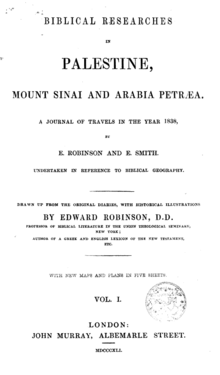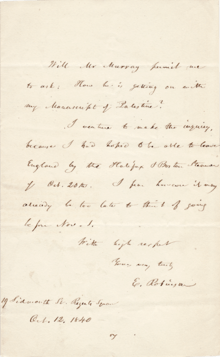Biblical Researches in Palestine
 Biblical Researches in Palestine cover | |
| Author | Edward Robinson |
|---|---|
| Translator | Eli Smith |
| Illustrator | Heinrich Kiepert |
| Country | United Kingdom, United States, Germany |
| Language | English |
| Genre | Travel literature |
| Publisher | John Murray |
Publication date | 1841 |
Biblical researches in Palestine, Mount Sinai and Arabia Petraea (1841 edition), also Biblical Researches in Palestine and the Adjacent Regions (1856 edition) was a travelogue of 19th century Palestine and the magnum opus of the "Father of Biblical Geography", Edward Robinson. The work was published simultaneously in England, the United States (dedicated to Moses Stuart) and Germany (dedicated to Carl Ritter).[1]
The work identified numerous Biblical localities for the first time, as well as significant Jerusalem archaeological sites such as Robinson's Arch (subsequently named for the author), and undertook the first scientific surveys of other sites such as the Siloam tunnel.[2]
Field work
Robinson made two journeys to Palestine. The first began on 12 March 1838 in Cairo, reached Jerusalem on 14 April, toured Arabia Petrea in May, arrived in Nazareth on 17 June, and ended in Beirut on 27 June;[3] The second began on 5 April 1852 in Beirut, where he arrived back again 19 June 1852 having explored much of Northern Palestine.[4]
Legacy
The work has been described as a "cornerstone of nineteenth century Palestine exploration".[5] Earlier descriptions had relied on the accounts of travellers and legends, whereas Robinson and his guide and translator Eli Smith relied on only what they saw for themselves.[6]
Albrecht Alt described the work as "epoch-making", and in describing the influence of the work in dispelling previously accepted knowledge of the region, stated: "he was able definitively to disprove a large part of what his predecessors had thought and had written. In Robinson's footnotes are forever buried the errors of many generations".[7]

Professor Thomas W. Davis noted that "all later archaeological research in Palestine is in some way indebted to [Robinson]. His geographical study marked a new era".[8] In a study of nineteenth century Biblical Studies in the United States, Jerry Wayne Brown described Robinson's work as "the most significant piece of American Biblical scholarship before the Civil War".[9]
References
- ↑ King 1983, p. 232.
- ↑ Currid, John D. (1999). Doing Archaeology in the Land of the Bible: A Basic Guide. Baker Academic. p. 25. ISBN 978-0-8010-2213-5.
- ↑ Hitchcock & Smith 1863, p. 68.
- ↑ Hitchcock & Smith 1863, p. 71.
- ↑ Goldman 2004, p. 215.
- ↑ Goldman 2004, p. 157.
- ↑ Alt 1939, pp. 373–374.
- ↑ Davis, Thomas W. (4 March 2004). Shifting Sands: The Rise and Fall of Biblical Archaeology. Oxford University Press. pp. 25–. ISBN 978-0-19-029045-0.
- ↑ Jerry Wayne Brown (1969). The Rise of Biblical Criticism in America, 1800-1870: The New England Scholars. Wesleyan University Press. p. 118. ; quoted in Jennifer Axsom Adler (2015), The Other Witness: Nineteenth-century American Protestantism and the Material Gospel Theology, p. 26
Bibliography
- Goldman, Shalom L. (2004). "Christian Hebraism and Palestine Exploration; Moses Stuart, Edward Robinson and Their Jewish "Informants"". God's Sacred Tongue: Hebrew and the American Imagination. University of North Carolina Press. pp. 137–162, 215. ISBN 978-1-4696-2023-7.
- King, Philip J. (1983). "Edward Robinson: Biblical Scholar" (PDF). The Biblical Archaeologist. The American Schools of Oriental Research. 46 (4): 230–232. JSTOR 3209782.
- Bartlett, John Raymond (1997). Archaeology and Biblical Interpretation. Psychology Press. pp. 4–. ISBN 978-0-415-14114-7.
- Bewer, Julius A. (1939). "Edward Robinson as a Biblical Scholar". Journal of Biblical Literature. The Society of Biblical Literature. 58 (4): 355–363. doi:10.2307/3259707. JSTOR 3259707.
- Alt, Albrecht (1939). "Edward Robinson and the Historical Geography of Palestine". Journal of Biblical Literature. The Society of Biblical Literature. 58 (4): 373–377. doi:10.2307/3259709. JSTOR 3259709.
- Hitchcock, Roswell Dwight; Smith, Henry Boynton (1863). The Life, Writings and Character of Edward Robinson: Read Before the N. Y. Historical Society. A. D. F. Randolph.
Online versions
- Robinson, Edward; Smith, Eli (1841). Biblical Researches in Palestine, Mount Sinai and Arabia Petraea: A Journal of Travels in the year 1838. 1. Boston: Crocker & Brewster. ; Also at Göttinger DigitalisierungsZentrum
- Robinson, Edward; Smith, Eli (1841). Biblical Researches in Palestine, Mount Sinai and Arabia Petraea: A Journal of Travels in the year 1838. 2. Boston: Crocker & Brewster.
- Robinson, Edward; Smith, Eli (1841). Biblical Researches in Palestine, Mount Sinai and Arabia Petraea: A Journal of Travels in the year 1838. 3. Boston: Crocker & Brewster.
- Robinson, Edward; Smith, Eli (1856). Biblical Researches in Palestine and adjacent regions: A Journal of Travels in the years 1838 and 1852, 2nd edition. 1. London: John Murray. ; Also at Göttinger DigitalisierungsZentrum
- Robinson, Edward; Smith, Eli (1856). Later Biblical Researches in Palestine and adjacent regions: A Journal of Travels in the year 1852. London: John Murray. ; Also at Göttinger DigitalisierungsZentrum
Maps
- Set of maps of Palestine, Mount Sinai, and Arabia Petraea (Accompanying the first edition)
- [1] Sinai / H. Kiepert del ; H. Mahlmann
- [2] Temple-area : ancient vaults / F. Catherwood del.
- [3] Tomb of Helena
- [4] Plan of Jerusalem : sketched from Sieber and Catherwood, corrected by the measurements of Robinson and Smith / drawn by H. Kiepert
- [5] Environs of Jerusalem : from the routes and observations of Robinson and Smith / drawn by H. Kiepert
- [6] Map of the peninsula of Mount Sinai and Arabia Petraea : from the itineraries of E. Robinson and E. Smith / constructed and drawn by H. Kiepert ; engr. on stone by H. Mahlmann.